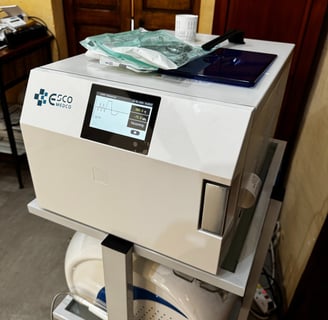Sterilisation - the key to eliminating cross-contamination
This blog describes the importance of sterilisation and the process that instruments go through in order to ensure that all possible microorganisms are eliminated
Professor Alfred Gatt
6/20/20251 min read
Sterilisation is a critical process to eliminate all forms of microbial life, including bacteria, viruses and spores, from surgical tools and other medical devices, ensuring they are safe for use in patient care. Thus it is the responsibility of every clinic to ensure that the proper sterilisation procedures are adhered to. This is not a simple process and needs very thorough documentation.
The process starts by careful washing of soiled instrument. This must be very thorough to physically remove contaminants such as blood. The next process involves further cleaning in an ultrasonic cleaner, to ensure that each instrument is carefully and thoroughly cleaned.
The instrument is then packed in a special sealed bag that has an indicator that changes colour when it is sterilised.
Autoclaving, using steam under pressure, is the most widely used and efficient method for surgical instruments. Instruments are subjected to a sterilization cycle (e.g., 121-134°C for 15-30 minutes), and then dried before storage. Autoclaves and other sterilization equipment require regular maintenance and testing to ensure proper function and effectiveness. In fact, besides running daily tests before sterilisation, technicians maintain and test the autoclave at regular intervals, keeping very thorough records of each process.
At the Podiatry Foot Clinic, we use the latest technology and ensure compliance with all regulations that the Department of Health Standards issue, to ensure patient safety.




Foot Care
Expert podiatry services for your foot health.
podgat@gmail.com
+356-99497886
© 2025. All rights reserved.
